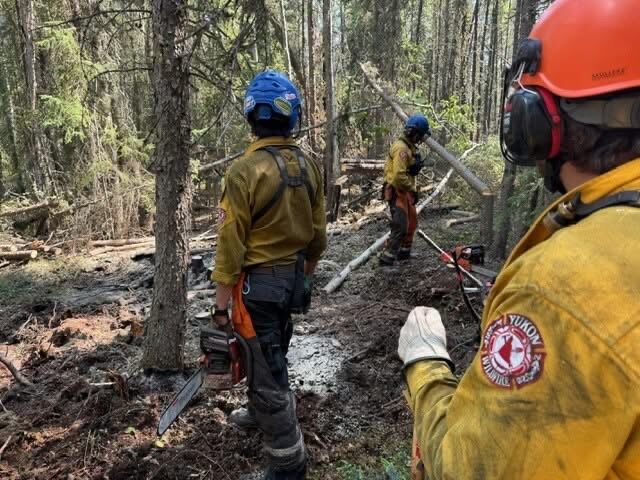It’s been an arduous season for firefighters across the territories, with 14 active fires in the N.W.T. alone and 16 fires declared out.
NWT Fire assured that wildfires in the NWT do not pose any danger to the public or to structures at this time, but warn the public to be cautious.
“Dry weather and possibly gusty winds are expected over the next couple of days,” cautioned NWT Fire.
In the South Slave region near the Alta. border, the Tulip Lake Wildfire remains held as crews continue a unified response.
“Fire crews are working under a unified command and are deploying crews and resources to limit the fire’s growth,” said officials.
Fire crews reported that activity on the Tulip Lake wildfire was “light” with “some isolated ignitions” of trees. Following a successful unified firefighter response that included crews from bordering territories and provinces, the fire continues to remain held and is no longer considered out of control.
“In the northeast area of the fire, crews continue to move south along the fire’s edge toward the Hanging Ice River, mopping up and extinguishing hotspots to secure the fire perimeter further,” said NWT Fire.
Crews are continuing their response also on the southeast corner of the fire, where they have located areas of heat and are soaking these hotspots with water. Firefighters in the southern area of the fire are making their way north to the fire’s perimeter.
On Monday night, infrared scans had identified hotspots and crews worked to extinguish those.
The fire began on May 30, located about 5 km northeast of Fort Fitzgerald and 28 km east of Fort Smith. The fire continues to hold at about 14,167 hectares in size.
Officials said the wildfire poses no risks to the community at this time.
Because of the significant decrease in fire activity, crews are continuing the removal of the high-volume sprinkler systems in Fort Smith and Fort Fitzgerald.
“Although the threat to these communities has been significantly reduced, firefighters will continue to monitor the fire for any increased activity on the west side,” assured NWT Fire.
A Wildfire Information Bulletin is available daily as this fire operation progresses. NWT asks anyone who would like more details to head to the webpage: https://www.gov.nt.ca/ecc/services/wildfire-update/en/fire/tulip-lake-fire
In South Slave region, there is another wildfire located about 13 km west of Highway 1 in the Cameron Hills. This fire continues to be monitored by Fire crews.
NWT Fire has cautioned that smoke plumes from this fire may continue to be visible from the highway. The fire is located close to an area that burned in 2024, limiting its possibility for growth in the areas near the highway.
This wildfire is 11,358 hectares in size and is considered out of control.
Fire crews have cautioned that smoke may be visible on Highway 1 and have urged the public to keep up-to-date on highway conditions at www.driventw.ca.
In the Sahtu region, two lightning-caused fires broke out earlier this week, including one located in the Tu’eyeta area, 92 km south of Fort Good Hope. A few days ago the wildfire was 39 hectares in size and has grown to about 323 hectares at its last measurement.
“There are currently no threats to communities, cabins, or infrastructure. This fire is currently being monitored,” said NWT Fire.
About 31 km northeast of Délı̨nę and 10 km west of Great Bear Lake, crews are responding to another lightning-caused fire, about 5 hectares in size.
“This fire is now considered to be under control Crews are still on hand to cold trail and start mop-up activities,” said NWT Fire.
Officials assured that there are currently no threats to communities, cabins, or infrastructure, cabins in the area are being monitored and structure protection will be set up if needed,” said NWT Fire.
In the Dehcho region, a lightning caused fire, first reported Monday about 50 km northeast of Wrigley near the Root River is reported to be about 1488 hectares in size at the last measurement.. The wildfire is being monitored by NWT Fire.
Fire officials assured that the fire is not considered a threat to communities, cabins or infrastructure at this time.
In the Dehcho region, a fire located about 74 km east of Fort Liard has grown to 15,654.00 hectares in size. The fire began on May 29 and crews continue to monitor its activity. There are currently no threats to communities, cabins, or infrastructure, said officials.
In the Dehcho region, a lightning-caused fire that began Sunday grew from 10 hectares to nearly 90 hectares in size on Monday, about 18 km northeast of Wrigley and 1 km north of Hodgson Creek. Crews are actively responding to the wildfire which remains 88 hectares in size. Crews warned of smoky conditions earlier this week.
“Crews continue to work on this fire. There are currently no threats to communities, cabins, or infrastructure in the area are being monitored and structure protection will be set up if needed,” said officials.
Two more lightning-caused fires were reported earlier this week in the Dehcho, including one that is about 12 hectares in size is located Near Fort Liard.
NWT Fire reported that tankers began a response on this fire late Tuesday and crews have been on site with air support to continue work on the fire. Structure protection was set up in the Bovie Lake area.
A smaller fire near Naylor’s Landing on the other side of the Mackenzie River from both Fort Simpson and Jean-Marie River is about 0.10 hectares in size, according to the last recorded measurements.
These wildfires are not considered a threat to either community, cabins in the area, or infrastructure at this time, said officials.
In the North Slave region, a new wildfire which began on Tuesday has been assessed northern point of Taché Lake by officials at about 40 hectares in size
Officials assured that this fire poses no threats to communities, cabins or infrastructure at this time.
NWT Fire cautioned the public to pay close attention to fire danger weather alerts and to avoid campfires if fire danger is high or extreme. They also urged the public to follow any fire bans in place.
A Full Fire Ban is again in effect for the town of Hay River. The town of Hay River had just recently lifted a fire ban which had been in place for several weeks.
“Due to the current dry conditions, ECC fire rating risk and lack of rain in the upcoming forecast, a fire ban that includes all fire pits is in place until further notice,” cautioned town officials.
For more information about fire danger and to access the live fire map along with detailed updates, head to www.nwtfire.com.





